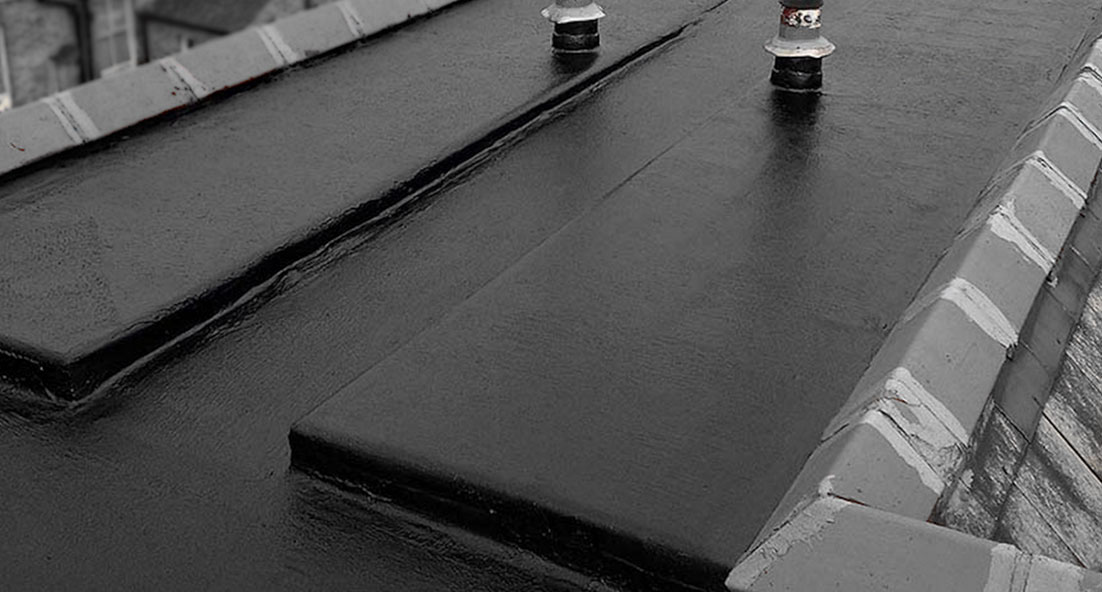
To stop a flat roof leak, the first thing to do is to ascertain where the water is coming in from. Unfortunately, it is often the case that the dampness inside does not correlate to the roof area directly above but can actually originate from a problem area a long way away.
The reason for this is that water can enter through a hole or surface crack and then track under the surface covering of the roof, especially layers of roofing felt, asphalt and single ply membranes, before finding its way to penetrate through to the room below. Leaks can also enter and flow along a joist before getting to a point where it will drip and/or run down a vertical surface.
Here are some of the most common places to look:
Cracks and Splits
Caused mainly from ageing, the material is not capable of properly expanding and contracting, resulting in the material splitting as the expansion is greater than expected.
Joins and Overlaps
A common cause for joins and overlaps leaking comes from the overlap not being very good. This causes the water then tracks in between the two layers. If the product has been heat welded together, it is common for this to be an area of concern. The join can split due to not being welded sufficiently. However, the material can split due to being weakened from over-heating the join and damaging/melting the material.
Around Vents/Roof-lights etc
A common cause here is that the flange around a vent is either not big enough and/or is ill fitting to the pipe or vent. It could also be due to not being sealed to the flat roof material and/or incorrect installation.
Lead Flashings or where the felt itself is flashed into the wall
It is well advisable to check along the joint where the roof material is built (flashed) into the adjoining wall. It is common for the installation to not be deep enough causing it to pop out,’ leaving a gap for the water to easily enter the building. This, however, usually happens over time by natural weathering. A common cause for this is due to water sitting on the ‘ledge’, soaking the cement joint, the water then freezes and with constant expansion and contraction, the joint begins to loosen, thereby causing a crack that results in water being able to pass through.
Screw / Bolt holes
There should be no bolt holes and screws passing through any flat roof material, but due to fitting of air conditioning units, railings, etc the silicones and mastics Harden causing them to fail in expanding and contracting sufficiently
Parapet Walls
The top of the brickwork often deteriorates and breaks down with weathering. If the brickwork has been covered with a concrete or stone coping, it is important to check how secure the coping is to the brickwork. You may well notice a crack between the coping and brickwork that then allows the water to track underneath. The water can then find its way into the cavity and can eventually show itself inside the building – and this can even be one or two storeys down
Change in angles, particularly along a 90⁰ corner / bend
Common when lining gutters, the covering of asbestos sheets or where the perimeter of the flat roof meets with a vertical wall, it is important to check these areas as the ridge or curvature puts differing stresses on the roof material. The 90⁰ angle is always an area to be checked first as cracking often occurs along this angle.
Glazing Bars
Old glazing was mostly installed and sealed with the use of putty which over a period of time not only becomes brittle, but also naturally loses is adhesive strength. Additionally, flat roof leaks can also be caused due to rotting/old timber.
Ridge Caps / Missing Foam Infills
Foam infills used to fill the gap, particularly on corrugated roofing breaks down (mostly by UV degradation) over the years and falls out. Equally it can pecked/removed by birds, eaten by insects and rodents which also means that the ‘remainder’ inevitably also falls out.
Now that we have identified some of the causes of the roof leaks, below we list ways to stop/prevent further damage.
In almost all cases, the use of a brush applied flexible coating (such as Polycote Wetterflex, Poloflex, Solarflex, Acraflex Std and also Acraflex RG ) not only provides great adhesion but will also remain flexible.
- When sealing splits and cracks, expansion joints, differing angles and glazing bars it is strongly advised that a flexible membrane is sandwiched between two coats as this can dramatically strengthen the coating and help prevent any further cracking.
- Apply one good coat and then stipple / brush the Flexible Membrane into the first coat and overlay with a second coat to completely sandwich the membrane.
- For wider splits, gutter joints and for where a thick repair might be needed such as the infilling of corrugations under ridge caps, etc
- For glazing bars, some people prefer to use instant waterproof flashing repair, as this can give a nice quick and neat finish with a lead type appearance.
